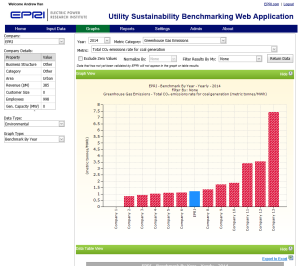New EPRI Database to Help Streamline Benchmarking

Sustainability is how a company balances environmental, social, and economic issues and decisions to ensure the long-term viability of the company itself, the community, and the environment. However, different stakeholders focus on and measure sustainability in a staggering variety of ways. Reporting organizations, such as the Dow Jones Sustainability Index, CDP (formerly the Carbon Disclosure Project), and the Global Reporting Initiative, use nearly 450 different criteria to measure and rank electric utilities’ sustainability. These criteria range from employee safety to the number of senior managers hired from the local community, and are distinct from performance measures that power companies must report to regulatory agencies. Reporting on a multitude of sustainability measurements—many of which may be less relevant to operations—can require resources better devoted to sustainability initiatives.
To make sustainability reporting more efficient, rigorous, and relevant, EPRI is developing an online database that equips electric utilities to benchmark sustainability performance using a carefully chosen set of 15 issues. “A lot of other organizations use long lists of metrics to benchmark electric utility performance and then publish company rankings based on the results,” said EPRI Technical Executive Jessica Fox. “No one knows this industry better than the power companies themselves, so the idea was to convene them to decide on the most relevant issues and metrics.” Fox and EPRI Technical Leader Morgan Scott manage EPRI’s Energy Sustainability Interest Group, which convenes 45 electric utilities to share sustainability best practices and advance technical work.
The streamlining of issues and metrics reflects the power industry’s desire to bring greater focus to measuring sustainability. Working toward alignment on the most important criteria and appropriate metrics will reduce reporting costs and improve information quality.
Defining Issues and Metrics
The online database, which is available this fall, builds on work by EPRI and the Tennessee Valley Authority (TVA). In 2015, EPRI assumed the environmental benchmarking effort that TVA maintained since 2010. EPRI brings to the task its recently completed research identifying the 15 most relevant sustainability issues in the North American electric power industry and expanding benchmarking beyond environmental measures to include social and economic performance (see sidebar). EPRI’s research team interviewed utility managers and other industry stakeholders, and compiled surveys filled out by 134 electric power company managers and stakeholders at government, private sector, nonprofit, environmental, and academic institutions.
In 2014, the Energy Sustainability Interest Group began work to identify two to five metrics for each of the 15 sustainability issues. This effort required consensus among companies of varying sizes and business models. An example: for greenhouse gas emissions, interest group members narrowed down 78 metrics to 7 that include emissions from owned generation, purchased power, and customers. The interest group has defined metrics for 11 of the 15 issues, with the remainder to be finalized in 2016.
A Versatile Tool
Companies that fund the project will have 24/7 access to the online benchmarking database, which they will use to store data, track performance, and compare with other participating companies. “Benchmarking used to be on hard copies, and you’d have to print out a lot of graphs,” said Fox. “With the online database, users will be able to apply filters, such as generation capacity, revenue, and organizational structure, so they can make the most relevant comparisons.” The database will also be used to produce metric summaries and reports on five-year trends.
“Some electric utilities may want to use the performance information from the tool to help guide internal planning and goal setting,” said Fox. “Others may use it to communicate with investors, regulators, and customers about their progress in sustainability. No matter how it’s used, it helps to have quick and easy access to this information.”
15 Sustainability Issues Identified by EPRI
- Greenhouse gas emissions
- Reductions of other air emissions
- Water quality
- Water availability
- Habitat protection and biodiversity
- Waste management
- Public safety and health
- Employee safety and health
- Job satisfaction
- Community support and economic development
- Engagement and collaboration
- Energy reliability
- Energy affordability
- Skilled workforce availability
- Economic viability of electric utilities
Sustainability: Not Just About the Environment
Environmental stewardship, such as protecting habitats and ensuring good air and water quality, is only part of what it means to be a sustainable electric utility. There are also important social and economic components, including community responsibility, employee safety, and having a sizable pool of skilled workers to prepare for the industry’s retirement wave. These factors, along with capital and assets, relate to another important sustainability issue: economic viability.
EPRI Technical Experts:
Jessica Fox, Morgan Scott
Further Resources:
- Material Sustainability Issues for the North American Electric Power Industry: Results of Research with Electric Power Companies and Stakeholders in the United States and Canada
- Sustainability Metric Compilation for the Electric Power Industry: Results of Industry Interviews and Metric Database Development


